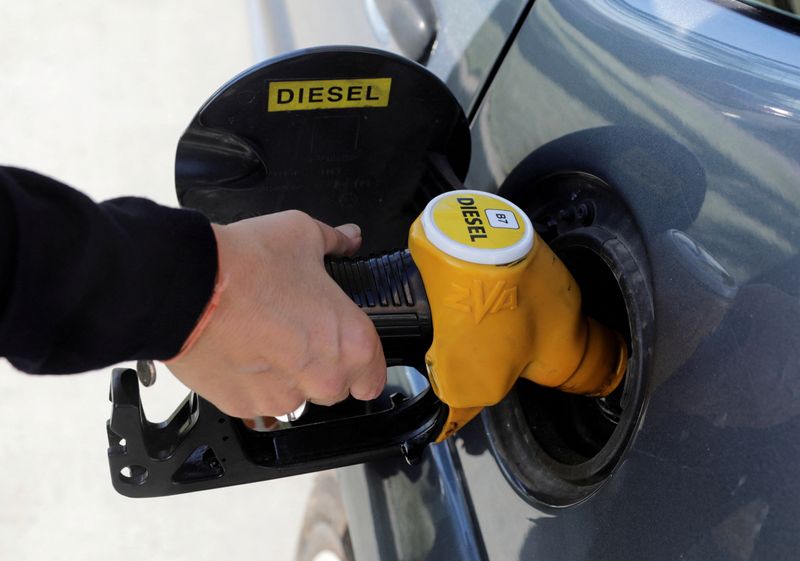Commodities
Oil rises but weak China data caps prices


© Reuters. FILE PHOTO: A diesel fuel nozzle with new European labels to standardise gasoline pumps in the EU zone is seen at a petrol station in Nice, France, October 12, 2018. REUTERS/Eric Gaillard/File Photo
By Robert Harvey
London (Reuters) – Oil prices edged up on Tuesday helped by a drop in euro zone inflation but were pinned below $90 a barrel on weak Chinese economic data and as the conflict in the Middle East remained contained.
December futures, were 85 cents, or 0.97%, higher at $88.30 a barrel by 1136 GMT ahead of their expiry later on Tuesday.
The more heavily traded January contract climbed 59 cents, or 0.68%,to $86.94. U.S. West Texas Intermediate crude rose 61 cents, or 0.74%, to $82.92.
Both Brent contracts traded $1 higher earlier in the day.
Euro zone inflation was at its lowest level in two years in October, falling to 2.9% from 4.3% in September according to Eurostat’s flash estimate.
Meanwhile, weaker-than-expected manufacturing and non-manufacturing activity data in China stoked fears of slowing fuel demand from the world’s No. 2 oil consumer.
Its official purchasing managers’ index missed a forecast and dipped back below the 50-point level separating contraction from expansion.
China’s fourth quarter fuel demand is expected to rise 10% year-on-year, PetroChina president Huang Yongzhang said on Tuesday.
Oil prices had fallen on Monday in part “because Israel’s ground offensive in the Gaza Strip is so far proceeding only gradually and has thus not yet sparked any further escalation of the Middle East conflict,” Commerzbank (ETR:) analysts said.
But investors continue to be wary of other countries in the region entering the conflict.
“Given the recalcitrant attitude of the warring parties and the potentially protracted and explosive nature of the ongoing conflict the Middle East premium will likely put a floor under the prices in the foreseeable future,” PVM’s Tamas Varga added.
Israel’s Prime Minister Benjamin Netanyahu dismissed calls for a halt to fighting to ease a humanitarian crisis on Tuesday, as Israeli forces attacked Hamas in the network of tunnels under the Palestinian exclave.
Markets were also keeping a close eye on a U.S. central bank meeting ending on Wednesday, despite a high likelihood it will keep interest rates steady, according to a poll by CME’s Fedwatch tool.
Commodities
Oil prices rise; U.S. crude inventories plunge, Russia-Ukraine truce eyed
Commodities
India’s Reliance to stop buying Venezuelan oil over US tariffs, sources say
Commodities
Oil prices climb on Venezuela supply worries

 Forex3 years ago
Forex3 years agoForex Today: the dollar is gaining strength amid gloomy sentiment at the start of the Fed’s week

 Forex3 years ago
Forex3 years agoUnbiased review of Pocket Option broker

 Forex3 years ago
Forex3 years agoDollar to pound sterling exchange rate today: Pound plummeted to its lowest since 1985

 Forex3 years ago
Forex3 years agoHow is the Australian dollar doing today?

 Cryptocurrency3 years ago
Cryptocurrency3 years agoWhat happened in the crypto market – current events today

 World3 years ago
World3 years agoWhy are modern video games an art form?

 Commodities3 years ago
Commodities3 years agoCopper continues to fall in price on expectations of lower demand in China

 Economy3 years ago
Economy3 years agoCrude oil tankers double in price due to EU anti-Russian sanctions























